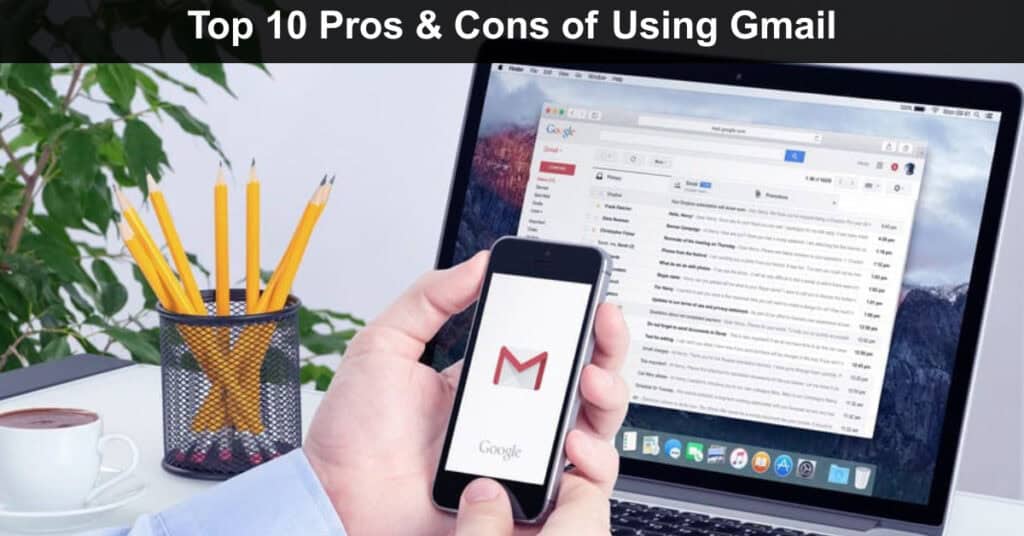
Gmail has long been one of the most popular email services worldwide, offering various features catering to personal and professional users. With its intuitive interface, seamless integration with other Google services, and powerful search capabilities, Gmail has become a global go-to platform for millions of users. However, like any technology, Gmail has its drawbacks, and understanding its advantages and disadvantages can help users make informed decisions about its use.
In this article, we’ll explore the top five pros and cons of using Gmail. We will delve into the features that make Gmail stand out among its competitors and discuss some of the limitations and challenges that users may encounter. By the end of this article, you’ll understand what Gmail offers and whether it’s the right email service for your needs.
The 10 Pros or Advantages of Using Gmail
Gmail’s widespread popularity is not without reason. Its user-friendly features, security, and integration with other Google products make it an attractive choice for many. Let’s look at five of the most compelling advantages of using Gmail.
Advantage #1: Seamless Integration with Google Services

Gmail’s integration with other Google services is one of its most powerful features. Whether it’s Google Drive, Google Calendar, or Google Meet, Gmail users can enjoy a seamless experience across the entire Google ecosystem. This integration saves time and enhances productivity by allowing users to access and share information quickly and efficiently.
To fully understand this advantage, consider the following specific benefits:
- Effortless file sharing through Google Drive integration
- Automatic syncing of events with Google Calendar
- Instant access to video conferencing via Google Meet
Real-Life Example: Imagine you’re coordinating a project with a team spread across different locations. Gmail lets you quickly share documents via Google Drive, schedule meetings with Google Calendar, and jump into a video call with Google Meet—all from your inbox. This level of integration streamlines communication and keeps everyone on the same page, making collaboration smoother and more efficient.
Advantage #2: Powerful Search Functionality
Thanks to Google’s expertise in search technology, Gmail’s search capabilities are second to none. Users can quickly find emails, attachments, and contacts by typing in keywords, dates, or other details. This powerful search functionality makes it easy to manage large volumes of emails and find the information you need in seconds.
Here are the key features that enhance this powerful search capability:
- Advanced search filters for precise results
- Ability to search within specific folders or labels
- Search by keyword, date, sender, or file type
Real-Life Example: If you’re looking for an important email from a client sent several months ago, Gmail’s search function can locate it in seconds. By entering the client’s name, a keyword related to the email, or a date range, Gmail will pull up the relevant conversation, saving you from manually sifting through hundreds of emails.
Advantage #3: Robust Spam Filtering
Gmail’s spam filtering is one of its strongest assets, keeping your inbox clean and free of unwanted emails. Gmail uses advanced algorithms to detect and filter out spam, phishing attempts, and other malicious emails, ensuring that you only see the messages that matter most. This intelligent filtering system continuously learns from user behavior, improving its accuracy over time and adapting to new types of spam threats.
The following points illustrate how this protection works for users:
- Automatic detection of spam and phishing emails
- Customizable spam filter settings
- Frequent updates to the spam filter algorithm
Real-Life Example: For small business owners who rely on email for client communication, Gmail’s spam filtering can be a lifesaver. By effectively filtering out spam and phishing attempts, Gmail helps protect your business from potential scams and keeps your inbox focused on legitimate inquiries and communications.
Advantage #4: Generous Storage Space
Gmail offers generous storage space, allowing users to keep many emails without worrying about running out of space. The default free tier provides 15 GB of storage, shared across Gmail, Google Drive, and Google Photos. Affordable upgrade options are available for those who need more space. This flexibility makes Gmail ideal for users who handle large volumes of attachments, such as photos, videos, or business documents, ensuring they can store and access their data without constant maintenance.
Key aspects of this storage offering include the following details:
- 15 GB of free storage
- Shared storage across Gmail, Google Drive, and Google Photos
- Affordable upgrade options for additional storage
Real-Life Example: Having ample storage space is crucial if you’re a freelancer managing multiple projects and clients. Gmail’s generous storage allows you to keep years of correspondence, contracts, and other essential documents without constantly deleting old emails to free up space.
Advantage #5: Easy Access on Multiple Devices
Gmail’s availability across multiple devices ensures that you can stay connected wherever you are. Whether you’re using a smartphone, tablet, or computer, Gmail’s responsive design and mobile apps make it easy to manage your email on the go. This cross-platform accessibility ensures that your emails, contacts, and settings remain synced in real time, providing a smooth and consistent experience no matter which device you use.
Specific features that facilitate this multi-device accessibility include the following:
- Responsive design for different screen sizes
- Dedicated mobile apps for iOS and Android
- Syncing across devices for a consistent experience
Real-Life Example: If you’re traveling and need to check your email, Gmail’s mobile app lets you stay on top of your inbox. Whether at the airport, in a meeting, or relaxing at a café, you can easily access your emails and respond to important messages from your phone or tablet.
Bonus Tip: Enhance Professionalism with a Gmail Signature
A well-crafted Gmail signature can elevate the professionalism of your emails. It typically includes your name, title, and contact information, but many users also choose to add logos, social media links, or legal disclaimers. To create a polished signature quickly, using a Gmail signature generator can be incredibly helpful. These tools, such as the Best Gmail Signature Generator, offer easy-to-use templates, allowing you to customize your signature to reflect your personal or business brand without the hassle of manual design.
The 5 Cons or Disadvantages of Using Gmail
While Gmail offers numerous benefits, it’s not without its downsides. Users may encounter several potential issues, from privacy concerns to functionality limitations. Here are five cons to consider when using Gmail.
Disadvantage #1: Privacy Concerns

One of the biggest concerns with Gmail is privacy. Google’s business model relies heavily on data collection, and Gmail users may worry about how their information is being used. Although Google has made strides to improve transparency and data protection, concerns about data privacy remain.
Several specific factors contribute to these ongoing privacy concerns for users:
- Google’s data collection practices for targeted advertising
- Potential access to personal emails by third parties
- Privacy concerns related to data storage and usage
Real-Life Example: If you’re a privacy-conscious user, you might be uncomfortable with the idea that Google could use your email data to serve targeted ads. While Google no longer scans Gmail content for ad targeting, the company still collects data across its services, which can feel invasive to some users.
Solution: To mitigate privacy concerns, users can explore Gmail’s privacy settings to limit data sharing, use encryption tools, or consider alternative email services that prioritize privacy. For users who find Gmail’s data practices incompatible with their privacy needs, secure email alternatives to Gmail that offer zero-access encryption and minimal data collection can provide greater peace of mind while maintaining email functionality.
Disadvantage #2: Limited Offline Access
Gmail’s offline capabilities are somewhat limited compared to other email clients. Although Gmail offers an offline mode, users must enable it manually, and the functionality is not as robust as other services. This can disadvantage users who frequently need to access their emails without an internet connection.
Key limitations of this offline mode include the following specific issues:
- Offline mode must be manually enabled
- Limited functionality in offline mode
- Not all emails and attachments are accessible offline
Real-Life Example: If you’re traveling in an area with poor internet connectivity, you might find Gmail’s offline mode lacking. While you can access recent emails and drafts, you may not be able to retrieve older emails or download large attachments, which can be frustrating when you need critical information.
Solution: To improve offline access, consider downloading emails and attachments you may need in advance or using third-party email clients that offer better offline capabilities.
Disadvantage #3: Ads in the Interface
Gmail’s web interface displays ads, which can be distracting and clutter the user experience. While the ads are generally hidden, they can still be a nuisance for users who prefer a clean and ad-free email environment. These ads are often tailored based on your online activity, which can raise privacy concerns and make some users feel their personal data is being used for marketing purposes.
The main issues regarding these advertisements are detailed in the points below:
- Ads displayed in the Promotions tab
- Potential for ads to appear in the primary inbox
- Ads based on user data, which can feel invasive
Real-Life Example: If you’re using Gmail for professional purposes, seeing ads in your inbox can be distracting and unprofessional. Even though the ads are typically placed in the Promotions tab, they may still disrupt your workflow and detract from the overall user experience.
Solution: Users can reduce the visibility of ads by using ad-blockers or opting for a Google Workspace subscription, which offers an ad-free experience.
Disadvantage #4: Limited Customization Options
While Gmail offers some customization options, it’s relatively limited compared to other email clients. Users looking for advanced customization of their email interface, themes, or organizational tools may find Gmail lacking. For instance, users cannot extensively modify the layout or add custom widgets, which limits their ability to tailor Gmail to their specific workflow preferences.
The following points highlight the restrictions on interface and theme personalization:
- Limited options for customizing the inbox layout
- Restricted ability to personalize themes
- Fewer organizational tools compared to other clients
Real-Life Example: If you like personalizing your digital workspace, Gmail’s limited customization options might be disappointing. You might prefer an email client that allows for more extensive interface customization, such as changing the layout and color schemes or adding custom folders and labels.
Solution: Consider using third-party apps or extensions that enhance Gmail’s functionality or explore alternative email clients that offer greater customization.
Disadvantage #5: Dependency on Google Ecosystem
Gmail’s deep integration with Google services is both a strength and a weakness. Users heavily invested in the Google ecosystem may find Gmail indispensable, but this dependency can also be limiting. If you want to move away from Google services, transitioning to another email platform can be challenging.
Specific challenges related to this ecosystem dependency are outlined below:
- Tight integration with Google services can create dependency
- Difficult to switch to other email platforms without data loss
- Potential for lock-in to the Google ecosystem
Real-Life Example: If you’re a long-time Gmail user who decides to switch to a different email provider, you might find it difficult to migrate your data, contacts, and emails without losing some of your information. This dependency on the Google ecosystem can make it challenging to explore other options.
Solution: Regularly back up your emails and contacts to ensure a smoother transition if you switch email providers. Consider using services that offer easy migration tools.
Conclusion
Gmail is undoubtedly one of today’s most feature-rich and user-friendly email services. Its integration with Google’s suite of products, powerful search capabilities, and robust spam filtering make it a top choice for individuals and businesses. However, it’s important to be aware of its limitations, such as privacy concerns, limited offline access, and the potential for dependency on the Google ecosystem. Ultimately, choosing Gmail depends on your specific needs and preferences.
If you value seamless integration with other Google services, generous storage, and advanced search functions, Gmail may be the perfect fit. However, if privacy, customization, and independence from the Google ecosystem are more important to you, it may be worth exploring other email options that better align with your priorities.
Suggested articles:
- Google Sheets: Top 10 Cons and Disadvantages
- Top 10 Cons & Disadvantages of Google
- Google Calendar API Integration: Best Practices, Security, and a Faster Path with Unipile
Daniel Raymond, a project manager with over 20 years of experience, is the former CEO of a successful software company called Websystems. With a strong background in managing complex projects, he applied his expertise to develop AceProject.com and Bridge24.com, innovative project management tools designed to streamline processes and improve productivity. Throughout his career, Daniel has consistently demonstrated a commitment to excellence and a passion for empowering teams to achieve their goals.